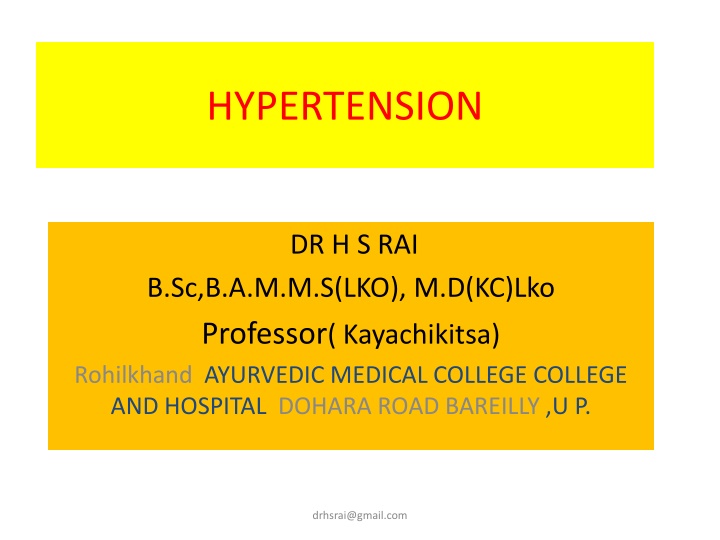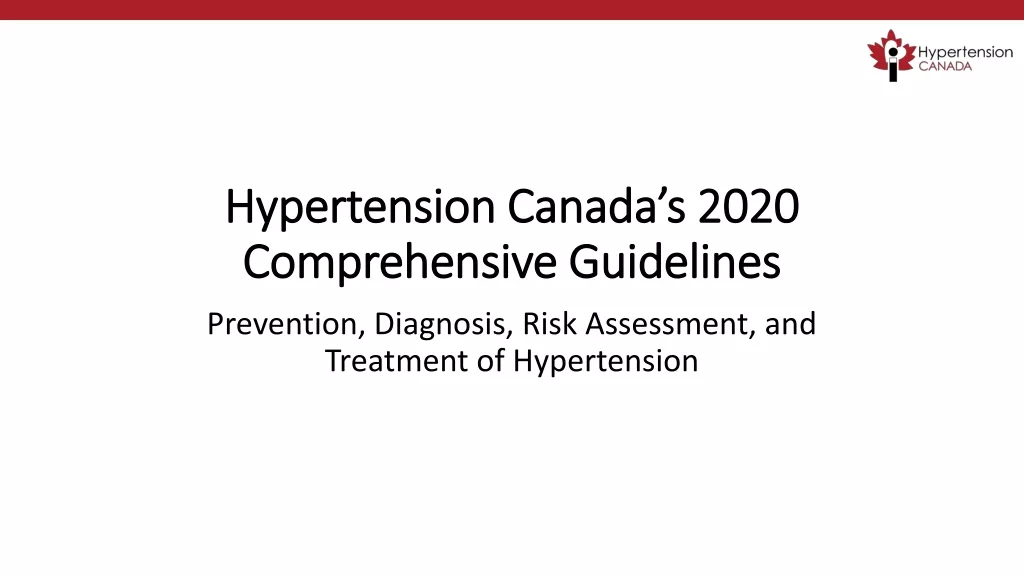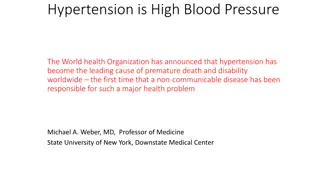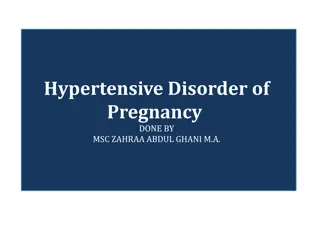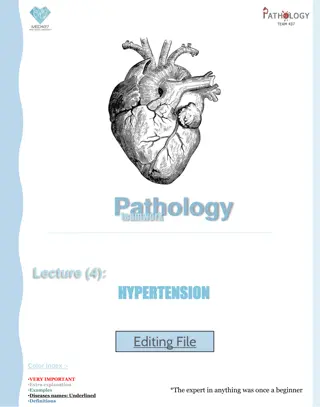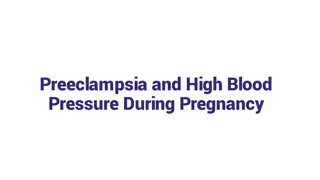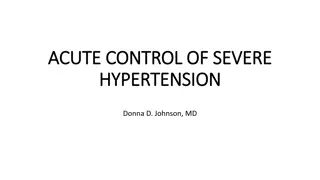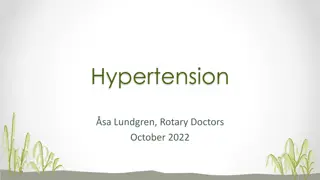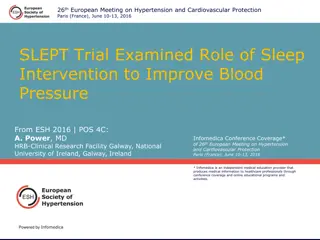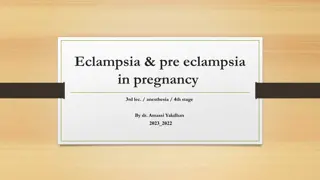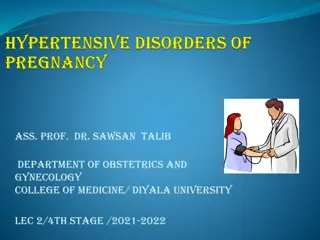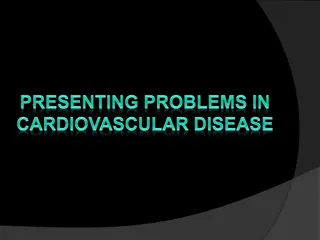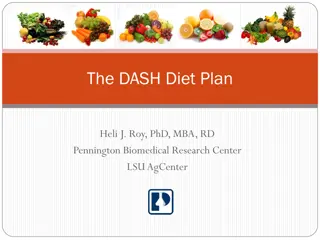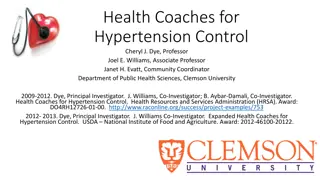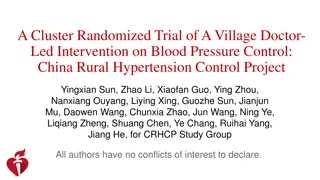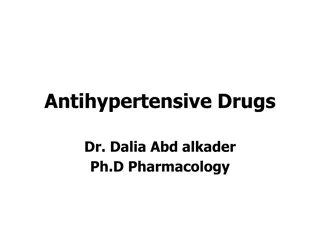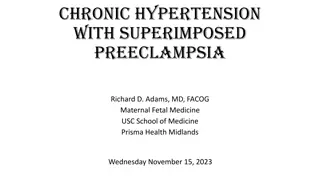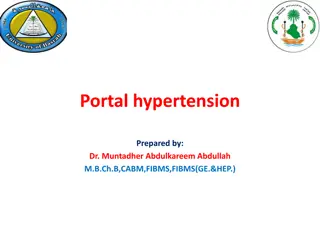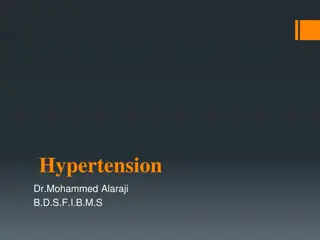HYPERTENSION
Hypertension, as defined clinically and physiologically by Dr. H.S. Rai, presents various clinical types with significant epidemiological impact in the US. Explore the pathologic consequences, blood pressure mechanisms, and consequences on organs like the heart, brain, and kidneys. Visualize the physiological aspects, hereditary factors, and health burdens associated with hypertension as explained by a seasoned Ayurvedic expert.
Download Presentation

Please find below an Image/Link to download the presentation.
The content on the website is provided AS IS for your information and personal use only. It may not be sold, licensed, or shared on other websites without obtaining consent from the author.If you encounter any issues during the download, it is possible that the publisher has removed the file from their server.
You are allowed to download the files provided on this website for personal or commercial use, subject to the condition that they are used lawfully. All files are the property of their respective owners.
The content on the website is provided AS IS for your information and personal use only. It may not be sold, licensed, or shared on other websites without obtaining consent from the author.
E N D
Presentation Transcript
HYPERTENSION DR H S RAI B.Sc,B.A.M.M.S(LKO), M.D(KC)Lko Professor( Kayachikitsa) Rohilkhand AYURVEDIC MEDICAL COLLEGE COLLEGE AND HOSPITAL DOHARA ROAD BAREILLY ,U P. drhsrai@gmail.com
Epidemiology In U.S.- prevalent in range of 21% to 33.5 % in different races,58.4 million have hypertenion Hereditary- blood pressure heritabilities are in the range of 15 35%. AGE- High blood pressure before age 55 occurs 3.8 times more frequently among persons with a positive family history drhsrai@gmail.com
HYPERTENSION - DEFINITION Clinically, hypertension might be defined as that level of blood pressure at which the institution of therapy reduces blood pressure related morbidity and mortality. Physiologcally hypertension is defined as lateral pressure exerted on arterial wall due to blood flowing across it. drhsrai@gmail.com
Clinical types of hypertension Labile-ranges normotensive to hypertensive Sustained-hypertensive Malignant-in range of 200/140 with papilledema Accelerated-rapid increase of BP Resistant-DO NOT RESPONSE TO TREATMENT drhsrai@gmail.com
BLOOD PRESSURE BLOOD PRESSURE IS BY PRODUCT OF CARDIAC OUT PUT AND PERIPHERAL REISSTANCE 1-CARDIAC OUTPUT- 1-STROKE VOLUME 2- HEART RATE 2-PERIPHERAL RESISTANCE- 1-VASCULAR STRUCTURE 2- VASULAR FUNCTION drhsrai@gmail.com
Pathologic Consequences of Hypertension HEART-LVH,CHF BRAIN-(STROKE ),INFARCTION,HEMORRHAGE KIDNEY-RENAL ISCHEMIA-RENIN ANGIOTENSIN-ALDOSTERONE PERIPHERAL ARTERIES-ATHEROSCLEROTIC CHANGES-INTERMITTENT CLAUDICATION drhsrai@gmail.com
The left ventricle is markedly thickened in this patient with severe hypertension that was untreated for many years. The myocardial fibers have undergone hypertrophy. Kieran McGlade Nov 2001 Department of General Practice QUB
This left ventricle is very thickened (slightly over 2 cm in thickness), but the rest of the heart is not greatly enlarged. This is typical for hypertensive heart disease. The hypertension creates a greater pressure load on the heart to induce the hypertrophy. drhsrai@gmail.com
CLINICAL DISORDER OF HYPERTENSION A-Essential hypertension B-Secondary hypertension drhsrai@gmail.com
Essential hypertension 80 95% of hypertensive patients are diagnosed as having "essential" hypertension (also referred to as primary or idiopathic hypertension drhsrai@gmail.com
SECONDARY HYPERTENSION In the remaining 5 20% of hypertensive patients, a specific underlying disorder causing the elevation of blood pressure can be identified . In individuals with "secondary" hypertension, a specific mechanism for the blood pressure elevation is often more apparent. drhsrai@gmail.com
Causes of Secondary hypertension RENAL-PARENCHYMAL DISEASE,RENAL CYSTS ,RENAL TUMOUR RENOVASCULAR-RENAL ARTERY STENOSIS ADRENAL-CUSHING SYNDROME,PHEOCHROMOCYTOMA,PRIMARY ALDOSTERONISM HORMONAL-THYROTOXICOSIS,ACROMEGALY NEUROGENIC CO-ARCTATION OF AORTA PREECLAMSIA/ECLAMSIA MEDICATIONS-High-dose estrogens, adrenal steroids, decongestants, appetite suppressants, cyclosporine, tricyclic antidepressants, monamine oxidase inhibitors, erythropoietin, nonsteroidal anti-inflammatory agents, cocaine drhsrai@gmail.com
RENAL HYPERTENSION RENAL PRENCHYMAL DISEASE TUBULOINTERISTITIAL DISEASE RENOVASCULAR DISEASE RENAL ATHEROSCHEROTIC PLAQUE FIBROMUSCULAR DYSPLASIA drhsrai@gmail.com
RENAL PARENCHYMAL DISEASE Virtually all disorders of the kidney may cause hypertension , and renal disease is the most common cause of secondary hypertension. Hypertension is present in >80% of patients with chronic renal failure. In general, hypertension is more severe in glomerular diseases than in interstitial diseases drhsrai@gmail.com
RENOVASCULAR DISEASE RENAL ARTERY STENOSIS Congenital Atherosclerotic plaque FIBROMUSCULAR DYSPLASIA- is characterized by fibrous thickening of the intima, media, or adventitia of the artery. and result in Narrowing the lumen drhsrai@gmail.com
Fibromuscular dysplasia Fibromuscular dysplasia, or fibromuscular dysplasia of arteries, often abbreviated as FMD, is a disease that can cause narrowing (stenosis) of arteries in the kidneys, the carotid arteries supplying the brain, and, less commonly, the arteries of the abdomen. FMD can cause hypertension, strokes, heart attacks, and arterial swelling (aneurysm) and dissection. drhsrai@gmail.com
BLOOD PRESSURE CLASSIFICATION SYSTOLIC-MMHG DIASTOLIC-MMHG NORMAL 90- 120 60- 80 PREHYPERTENSION 120-139 80-89 STAGE 1 HYPERTENSION 140-159 90-99 STAGE 2- HYPERTENSION 160 AND MORE 100 AND MORE ISOLATED SYSTOLIC HYPERTENSION 140 MORE LESS THAN 90 drhsrai@gmail.com
RENIN ANGIOTENSIN ALDOSTERON drhsrai@gmail.com
RENIN ANGIOTENSIN ALDOSTERONE AXIS drhsrai@gmail.com
Systolic Hypertension with Wide Pulse Pressure 1. Decreased vascular compliance (arteriosclerosis) 2. Increased cardiac output a. Aortic regurgitation b. Thyrotoxicosis c. Hyperkinetic heart syndrome d. Fever e. Arteriovenous fistula f. Patent ductus arteriosus drhsrai@gmail.com
Clinical symptoms HEADACH DIZZINESS BLURRING OF VISION NAUSEA AND VOMITING PALPITATION DAY TIME SOMNOLESCENCE COMA DEATH drhsrai@gmail.com
Approach to the Patient: Hypertension HISTORY-Duration of hypertension Previous therapies: responses and side effects Family history of hypertension and cardiovascular disease Dietary and psychosocial history Other risk factors: weight change, dyslipidemia, smoking, diabetes, physical inactivity Evidence of secondary hypertension: history of renal disease; change in appearance; muscle weakness; spells of sweating, palpitations, tremor; erratic sleep, snoring, daytime somnolence; symptoms of hypo- or hyperthyroidism; use of agents that may increase blood pressure drhsrai@gmail.com
PHYSICAL EXAMINATION MEASUREMENT OF BLOOD PRESSURE PHYSICAL EXAMINATION ASSESSMENT OF AFFECT RULE OUT THE SECONDARY CAUSE LAB TESTING Renal Microscopic urinalysis, albumin excretion, serum BUN and/or creatinine Endocrine Serum sodium, potassium, calcium, ?TSH Metabolic Fasting blood glucose, total cholesterol, HDL and LDL (often computed) cholesterol, triglycerides Other - Hematocrit, electrocardiogram drhsrai@gmail.com
TREATMENT LIFESTYLE INTERVETION- Dietary modifications that effectively lower blood pressure are weight loss, reduced NaCl intake, increased potassium intake, moderation of alcohol consumption, and an overall healthy dietary pattern PHARMACOLOGICAL OR DRUG TREATMENT drhsrai@gmail.com
Drug treatment Examples of Oral Drugs Used in Treatment of Hypertension Drug Class Examples Usual Total Daily Dosea (Dosing Frequency/Day ) Other Indications Contraindicatio ns/Cautions Diuretics Thiazides Hydrochlorothiazi de Chlorthalidone 6.25 50 mg (1 2) Diabetes, dyslipidemia, hyperuricemia, gout, hypokalemia 25 50 mg (1) drhsrai@gmail.com Loop diuretics Furosemide 40 80 mg (2 3) CHF, renal failure Diabetes, dyslipidemia,
CONTINUED Alpha antagonists Selective Prazosin 2 20 mg (2 3) Prostatism Doxazosin 1 16 mg (1) Terazosin 1 10 mg (1 2) Nonselective Phenoxybenzami ne 20 120 mg (2 3) Pheochromocyto ma Sympatholytics Central Clonidine 0.1 0.6 mg (2) Clonidine patch 0.1 0.3 mg (1/week) 250 1000 mg (2) Methyldopa drhsrai@gmail.com
antagonists Dihydropyridines 3d degree heart block Nifedipine (long acting) Verapamil (long acting) Diltiazem(long- acting) 30 60 mg (1) Angina CONTINUED Nondihydropyridin es 120 360 mg (1 2) Post-MI, supraventricular tachycardias, angina 180-420 mg (1) drhsrai@gmail.com
CONTINUED Nondihydropyri dines Verapamil (long acting) 120 360 mg (1 2) Post-MI, supraventricular tachycardias, angina DILTIAZAM 180-420MG(1) Direct vasodilatores hydralazine 25-100 mg(2) Severe coronary arery diseases Minoxidil 2.5 to 8 mg drhsrai@gmail.com
Management of Hypertension AYURVEDIC APPROACH Drug Treatment Sarpagandha : For centuries Rauwolfia serpentina has been used to treat hypertension. JATAMANSI
CONTINUED Arjuna : Terminalia arjuna produced dose- dependent hypotension in anaesthetized dogs. Action of mechanism for this particular herb is that it acts like a beta-blocker and is a powerful antioxidant, liver protecting and contains cardio-protective, hypolipidemic, anti-angina and anti-atheroma properties. drhsrai@gmail.com
CONTINUED Gokshura : Tribulus terrestris(gokshura) is a natural herb used for treating many diseases including hypertension. It has shown to be diuretic and an ACE inhibitor. Punarnava : Boerhaavia Diffusa has diuretic and Ca2+ channel blocking activity. Rose Pattel Jam(Gulkand) : It has calming and mood lifting effects drhsrai@gmail.com
CONTINUED GARLIC-BY LOWERING THE LIPIDS AND VATASHAMAK. TRIPHALA- VIRECHANA , SROTAS SANSHODHANAM drhsrai@gmail.com
PANCHAKARMA NIRUDHA VASTI SHIRODHARA THERAPY -Dhara therapy is also helpful in treating obstinate cases of hypertension. Oil processed with bala (sida cordifolia) and milk is allowed to drop in small droplets on the forehead of the patient. drhsrai@gmail.com
TREATMENT OF DOASHA When Vata predominates, An increase in blood pressure will be followed by worry, strain, overwork, anxiety or insomnia. It frequently associated with nervous system disorders.anxiety, worry, stress, and strain, are usually the main factors, therefore, treat the psychological conditions. Vata Treatment Take 125 mg.of sarpagandha (raulfia serpentina) and jatamansi 3 times daily for 2 3 months. Garlic is very good for this condition. Eat an entire crushed clove (with honey) once or twice a week. Take nutmeg or saraswat powder in warm milk. Take Ashwagandha preparation drhsrai@gmail.com
PITTA PREDOMINANCE When Pitta predominates, anger,nose bleed, Irritability, and Violent headaches Sensitivity to light contribute to high blood pressure. Pitta Treatment - Use tranquilizing herbs that have cold potency. For example, take 250 mg. of Brahmi at night. Brahmi Rasayana Saraswat powder To purify Pitta, take 1 gram each of Indian sariva for 15 days. drhsrai@gmail.com
KAFF PREDOMINANCE When Kapha is prominent, there may be dull headache,edema, lethargy with obesity.blood pressure remains continually high. (no fluctuation as in Pitta hypertension.) Kapha Treatment - Avoid dairy, butter, eggs and high fat foods. - 1 gm. of guggulu or arjuna twice daily, or 250 mg. of shilajit 3 times daily for 3 months can be taken. Kapha type of hypertension is almost due to arteriosclerosis (deposition of fat inside the arteries - making their lumen narrow- causing hypertension). All the above herbs remove arteriosclerosis. Optimal mixture is Triphala guggulu 1 gm. daily for 3 months. 100 mg. of cardamom and cinnamon 3 times daily is beneficial. Take these mixtures for 3 months. Regularly check blood pressure drhsrai@gmail.com
END Thanks More prospective approach to ayurvedic treatment is invited drhsrai@gmail.com
